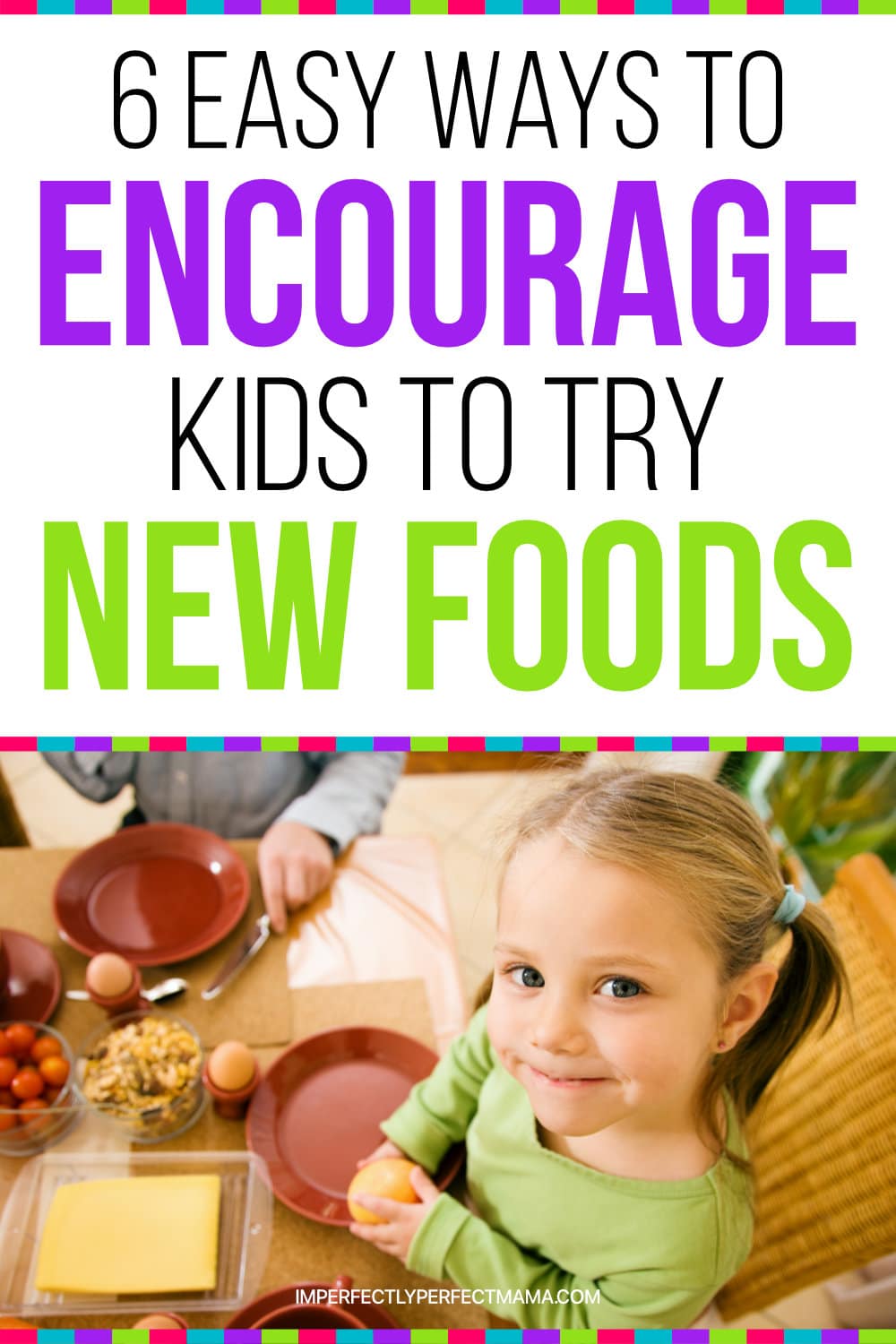It’s not something you think about before you’re in the thick of parenting because eating seems so “natural.”

Then suddenly, you find yourself asking, “How in the world do I get my child to eat something besides mac and cheese and dino nuggets?”
Now if that’s all you want to serve, nobody’s judging around here.
But if you’d like to help your kids try (and even learn to like) a variety of foods, these six tips will help you encourage your kids to try new foods.
These ideas are a good way to get your toddler to try new foods, all the way up into the older years.
1. Set an Example of Trying New Foods
Our kids are always watching us, and learning from our example. If you eat a variety of foods, it’s more likely your child will eventually do the same.
Make it obvious that you also eat foods you haven’t tasted before.
Show curiosity about different cuisines or recipes. Explain how you found a new dinner idea and why you’re excited to try it.
As a family, you could start a tradition of trying a recipe once a month that’s new to all of you.
Kids might enjoy looking through pictures and choosing the menu.
You can show that trying something new is like a mini adventure; you never know what you’re going to get for sure, but like it or not, it’s all part of the experience.
2. Make New Foods Look Appealing
While babies won’t notice, as kids get older presentation does make a difference.
One simple idea is to cut sandwiches into a shape for lunch, such as a heart or the first letter of your child’s name.
You can arrange foods in fun ways, like making a caterpillar out of vegetables or a rainbow out of fruits.
Another simple idea is to connect the new food with something they enjoy, such as pointing out that Brussel sprouts look an awful lot like green soccer balls.
Don’t feel pressured to make your meals exciting or interesting like this all the time, but once in a while or when you’re introducing a new food it can be helpful and fun!
3. Set Reasonable and Consistent Expectations

Decide what feels reasonable for your family when it comes to new foods that are served at mealtimes. Does everyone need to eat a plateful or a bite?
Is it okay to choose something simple instead (like a piece of bread), or do family members need to get full with the choices on the table?
For example, in our family everyone is expected to have one bite of each food on the table, and we all only eat what’s served.
I try to be reasonable by including a healthy, simple side that the kids like when I’m making a new recipe that the kids might not like, or I make the new dish as the side to a main meal they already like.
Another way to make expectations reasonable is to allow kids to have some choice.
For example, you might choose when the family eats, but your child can choose how much. Giving choices like this helps your child feel a sense of control, which we all appreciate!
Plus, it prevents the power struggle that sometimes leads kids to refuse new foods.
After determining your reasonable expectations, be really kind, calm, and consistent about upholding them.
You can hold expectations without it feeling like a battle by choosing to use an upbeat and kind tone of voice.
Teaching mealtime expectations is a process, so be patient as your family learns together.
You can learn more about teaching healthy eating expectations here.
4. Offer a New Food at Many Meals Because Taste Buds Change
Most of us have a story about a food we used to hate but now enjoy.
Share those stories with your kids, and remind them that taste buds change.
We keep trying foods (even when they weren’t our favorite before) because you never know when that food will suddenly become your new favorite.
Plenty of studies back this up too.
One review of the research stated, “New foods may need to be offered to preschool-aged children ten to sixteen times before acceptance occurs.
At the same time, simply offering new foods will not necessarily produce liking; having children taste new foods is a necessary part of the process…approximately one quarter of parents with infants and toddlers prematurely drew conclusions about their child’s preference for foods after two or fewer exposures.”
So we continue to offer those new foods over, and over, and over.
5. Mix the New Food With Something Your Child Already Likes

Serve a new food on a plate with other foods that are familiar.
Or mix the new food into a recipe.
Smoothies are a great way to mix a variety of foods and introduce new ones.
A simple, flexible recipe is to blend two cups water, 1 cup greens, and 1 cup fresh or frozen fruit.
You can experiment with all different combinations of fruits and greens this way.
When offering a new food alone, you can share how a child has already enjoyed the food as part of a recipe, like the famous example that tomatoes make ketchup.
6. Include Kids in the Kitchen
When kids are involved in the process of preparing a meal, they’re much more likely to eat it.
So whether they help pour ingredients, cut with a butter knife, or mix the food, find ways to frequently include your child as you make meals.
Cooking together is also a great opportunity to create a fun memory surrounding food.
The emotional experiences our kids have around food impact the future relationship they will have with eating, so keep things positive.
I hope these six tips are helpful as you teach your child to try new foods and maybe even enjoy them! Changes in eating habits usually don’t happen overnight.
It’s a process, so stay patient, positive, and upbeat. But remember, if you need to fall back on mac and cheese and dino nuggets frequently, nobody’s judging.




Leave a Reply